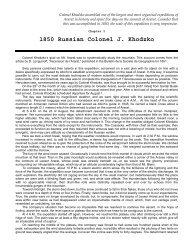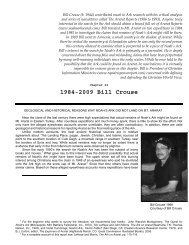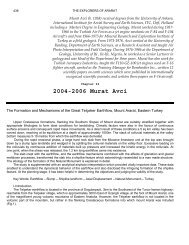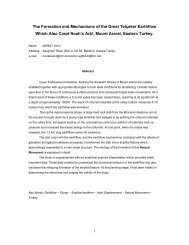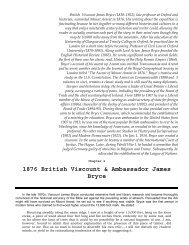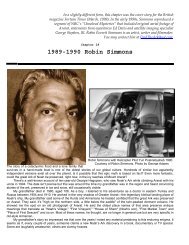THE BOUNDARIES OF URARTU/ARARAT
THE BOUNDARIES OF URARTU/ARARAT - Noah's Ark Search
THE BOUNDARIES OF URARTU/ARARAT - Noah's Ark Search
You also want an ePaper? Increase the reach of your titles
YUMPU automatically turns print PDFs into web optimized ePapers that Google loves.
Introduction<br />
<strong>THE</strong> <strong>BOUNDARIES</strong> <strong>OF</strong> <strong>URARTU</strong>/<strong>ARARAT</strong><br />
By Rex Geissler, Gordon Franz, and Bill Crouse<br />
December 24, 2008<br />
Adventurer Robert Cornuke produced a new video which claims that remnants of<br />
Noah’s Ark have been found in the Elburz Mountains about 54 miles from<br />
Tehran, the capital of Iran. A critique of the new video by Gordon Franz, Bill<br />
Crouse, and the author is available at<br />
http://noahsarksearch.com/Cornuke_The_Search_For_Noah%27s_Ark_DVD_Re<br />
view.pdf. Among the other issues sited, one of the largest problems with<br />
Cornuke’s view is that he distorts the boundaries of ancient Urartu/Ararat.<br />
The Boundaries of Ararat/Urartu<br />
The major problem with the Cornuke thesis is that there is no evidence yet<br />
discovered that indicates the region of Urartu/Ararat ever extended as far east into<br />
Iran as he claims. In fact, in the video, Cornuke’s map doesn’t even cover the<br />
ancient capital of Ararat/Urartu on Lake Van! This is a grievous error. What is at<br />
stake here is the inerrancy of Scripture. As far as these authors are aware, no<br />
Urartian scholar would put the Kingdom of Urartu as far to the east as Cornuke<br />
claims even at the height of its empire in the 8 th and 7 th centuries B.C. when<br />
Urartu included about 500,000 square kilometers (193,000 square miles). At the<br />
most, it extended only a few miles south and east of Lake Urmia. Most scholars<br />
are in agreement that when the author of Genesis referred to the mountainous<br />
region of Ararat in Gen. 8:4, he was making reference to the region directly north<br />
of Mesopotamia, centered around Lake Van (Zimansky 1998: 2). The tribes and<br />
regional kings of Ararat (Urartu) are first mentioned in Assyrian literature in the<br />
13 th century B.C. meaning it could easily have been in existence and known by<br />
Moses (Zimansky 1998: 6).
2<br />
Urartu Map based upon Soviet Archaeologist Boris Piotrovsky’s Excavations in Armenia<br />
The Urartu archaeological map extended with more labels is from noted Urartian<br />
Archaeologist Boris Piotrovsky, who was Director of the Hermitage Museum in<br />
St. Petersburg for the Soviet Union and directed the Urartian excavations at<br />
Karmir-Blour, one of the greatest fortresses of Urartu in Soviet Armenia (1969:<br />
back cover). In order to accurately demonstrate how different Bob Cornuke’s map<br />
of Urartu shown in the video, the archaeological map of Urartu based upon<br />
Piotrovsky and Zimansky (1998: 2, 230-231) had to be completely re-drawn below<br />
(outlined in red with Urartian archaeological sites) in order to add entire areas of<br />
landmass to take into account Cornuke’s view of Urartu (outlined in blue and<br />
adapted from the locations shown on the video into a new map).<br />
Cornuke literally leaves out 36,500 square miles of the accepted archaeologists’<br />
view of Urartu. In addition, it should be noted that Cornuke adds about 28,000<br />
square miles of geographical area to his map of Urartu with no archaeological
3<br />
support whatsoever, allowing his map to include some of the northern and central<br />
Elburz Mountains close to Mount Suleiman.<br />
Archaeological Urartu (Red) with Urartian Archaeological Sites (Orange)<br />
Using Urartian and Assyrian research from Dr. Paul Zimansky and H. Kessler and noting<br />
the Mountain Buffer Zones of Gordyene, Taurus, and Zagros Mountains<br />
Compared with Cornuke’s Urartu (Blue)<br />
The presumed Ed Davis landing site on Mount Suleiman, northwest of Tehran, is<br />
far outside the land of Ararat/Urartu (at least 250 miles as the dove flies from<br />
Urartu to Mount Suleiman), and deep inside the Land of Madaia of the Medes!<br />
This is a very crucial point to Cornuke’s claims. Is Mount Suleiman, northwest of<br />
Tehran, in the Biblical land of Ararat/Urartu or not? The BASE Institutes case<br />
stands or falls on this question. Cornuke gives a vague, non-factual answer to<br />
this question when he states:<br />
When people talk about the boundaries of Urartu -- which is the Assyrian<br />
designation, Armenia, [the] more modern designation -- They can’t be precise.<br />
There is not a boundary that you can draw a line around. It expanded and<br />
contracted up to a thousand [1,000] miles based on war, or famine, or some<br />
kind of drought, very mercurial in the boundaries. So we can say it’s just right<br />
in that area of Turkey, the area of Iran, the area maybe of Azerbaijan. It’s just<br />
right in that area of the world; we just can’t be precise where in the area when
4<br />
we are talking about Iran. It’s right where the Bible indicates it should be<br />
[12 min.:30 sec.-13 min.:08 sec. into the video].<br />
However, in the video, a speculative map of Ararat/Urartu graphic is shown that<br />
includes Mount Sabalan and comes close to Mount Suleiman. Cornuke knows<br />
he must have the Land of Ararat/Urartu extend all the way over to the Elburz<br />
mountain range in order to give his discovery any kind of credibility. It is our<br />
judgment that this graphic is very inaccurate and, in our opinion, deceptive. As<br />
noted earlier, Cornuke’s Urartu map does not even include the known historical<br />
capital and cultural center of Ararat/Urartu at Lake Van and its associated<br />
archaeological sites, the large Urartian site of Çavuştepe toward Hakkari or other<br />
numerous Urartian archeological sites between Lake Urmia and Lake Van, nor<br />
none of the traditional Hurrian highlands extending west to Erzincan and Elizağ.<br />
However, Cornuke’s Urartu does conveniently extend southeast to the central<br />
Elburz Mountains and the edge of Mount Suleiman where not one piece of<br />
evidence for Urartian presence has ever been found.<br />
Here is a brief summary of the region of Ararat/Urartu by noted expert Paul E.<br />
Zimansky and notice that none of the landmarks he mentions are deep within<br />
Iran. He states:<br />
Urartian kings would have ruled all of the agricultural lands around Lake Van<br />
and Lake Sevan, and the southwestern shore of Lake Urumiyeh. The upper<br />
Aras, particularly the Armavir and Erevan areas, was firmly in their hands, and<br />
conquest took them as far north as Lake Cildir. Along the Murat, evidence for<br />
royal control is surprisingly meager, but sufficient to put the Euphrates at Izoli<br />
within the conquered zone and the Elazig area in the narrower sphere.<br />
Campaign inscriptions are found well to the east of Tabriz, but the nearest<br />
evidence for firm state control in that direction comes from Bastam, thirty-eight<br />
kilometers north of Khvoy. Missing from this picture are the large and fertile<br />
plains of Erzurum and Erzincan on the Karasu, the northwest shore of Lake<br />
Urumiyeh, the plain of Marand, and the middle Aras from Jolfa to the slopes of<br />
Mount Ararat. All of these are generally assumed to be part of Urartu in some<br />
sense, and it is worth examining other forms of evidence to see if there might<br />
be some grounds for including them within the perimeter of state control<br />
(1985: 10).<br />
Zimansky does not include the Elburz Mountains in the area of Urartu. Thus, it<br />
is NOT, as Mr. Cornuke claims, right where the Bible indicates it should be!
5<br />
Bibliography<br />
Corbin, B. J.<br />
1999 The Explorers of Ararat: And the Search for Noah’s Ark. 2 nd ed.<br />
Highland Ranch, CO: Great Commission Illustrated Books.<br />
http://www.noahsarksearch.com<br />
Cornuke, Robert<br />
2005 Ark Fever. The True Story of One Man’s Search for Noah’s Ark.<br />
Wheaton, IL: Tyndale House.<br />
Cornuke, Robert; and Halbrook, David<br />
2001 In Search of the Lost Mountains of Noah. The Discovery of the<br />
REAL Mountains of Ararat. Nashville, TN: Broadman and Holman.<br />
Crouse, Bill<br />
1988 Is the Ark in the Ahora Gorge? Ararat Report #14 (Jan.-Feb.).<br />
1989 The Ed Davis Testimony: An Addendum. Ararat Report #20 (Jan.-<br />
Feb.).<br />
1993 Modern Eyewitnesses: Are They Reliable? Ararat Report #32<br />
(May).<br />
Crouse, Bill; and Franz, Gordon<br />
2006 Mount Cudi – True mountain of Noah’s Ark. Bible and Spade 19/4:<br />
99-113. http://www.biblearchaeology.org/publications/BAS19_4.pdf<br />
Gansser, Augusto; and Huber, Heinrich<br />
1962 Geological Observations in the Central Elburz, Iran.<br />
Schweizerische Mineralogische und Petrographische Mitteilungen<br />
42: 583-630.<br />
Geissler, Rex; Basaran, Cevat; and Keles, Vedat<br />
2006 Mount Ararat Archaeological Survey. Bible and Spade 21/3: 70-96.<br />
http://arcimaging.org/Mount_Ararat_Archaeological_Survey.pdf<br />
Josephus<br />
1965 Antiquities of the Jews. Book 20. Vol. 10. Trans. by L. H.<br />
Feldman. Cambridge, MA: Harvard University. Loeb Classical<br />
Library 456. Reprinted 1981.<br />
Mathews, Kenneth<br />
1996 Genesis. Vol. 1. Nashville, TN: Broadman and Holman.
6<br />
Piotrovsky, Boris B.<br />
1969 The Ancient Civilization of Urartu: An Archaeological Adventure.<br />
Trans. by James Hogarth, from Russian. New York: Cowles Book.<br />
Rawlinson, Major Henry<br />
1839 Notes on a March from Zohab, at the Foot of Zagros, along the<br />
Mountains to Khuzistan (Susiana), and from Thence Through the<br />
Province of Luristan to Kirmanshah, in the Year 1836. Journal of<br />
the Royal Geographical Society of London 9: 26-116.<br />
Shockey, Don<br />
1986 The Painful Mountain. Fresno, CA: Pioneer.<br />
Wenham, Gordon<br />
1991 Word Biblical Commentary. Genesis 1-15. Vol. 1. Milton Keynes,<br />
England: Word (UK).<br />
Zimansky, Paul<br />
1985 Ecology and Empire: The Structure of Urartian State, Chicago:<br />
University of Chicago.<br />
1998 Ancient Ararat: A Handbook of Urartian Studies. Delmar, NY:<br />
Caravan Books.<br />
About the authors:<br />
Rex Geissler is a computer specialist, publisher, researcher, and the president of<br />
Archaeological Imaging Research Consortium (ArcImaging)<br />
http://www.arcimaging.org<br />
Gordon Franz is Bible teacher, and an archaeologist on the staff of the<br />
Associates for Biblical Research http://www.biblearchaeology.org<br />
Bill Crouse is a researcher and president of Christian Information Ministries<br />
http://www.rapidresponsereport.com



